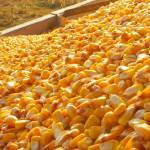Avoid Risks from Fumonisin in Corn

Fumonisin is a toxic substance produced by at least two species of fungus, Fusarium moniliforme and Fusarium proliferatum that grow on corn. Unlike some fungus or mold species that cause problems in stored grain, Fusarium grows on corn plants before they are harvested. Stress from weather or insect damage can make plants more susceptible. In wet growing seasons or areas with high humidity, close to 100% of the plants may be affected.
What happens to a horse that eats grain contaminated with fumonisin?
Equines are more sensitive to this toxin than other livestock species. Horses eating corn with a level of contamination as low as 2 parts per million (ppm) are at serious risk of developing equine leukoencephalomalacia, or ELEM. This neurologic condition, also known as moldy corn poisoning, is characterized by loss of appetite, weakness, poor coordination, depression, and blindness. An affected horse may stumble, walk in circles, or stand with its head pressed against solid objects. Liver damage is also common. By the time signs are exhibited, treatment is usually not effective, and little can be done to save the horse’s life.
Is contamination a widespread problem?
A 1998 USDA study of horse operations in 28 states showed detectable levels of fumonisin in feed from 40% of tested farms. About 5% of owners or managers were feeding grain or grain products containing a dangerous level of contamination. Significantly, operations feeding home-grown corn were more than ten times as likely to have levels of 2 or more ppm than those feeding commercially supplied grain or grain products.
Is fumonisin a hazard to other animals or to humans?
Although sensitivity varies, other animals and humans can be adversely affected by fumonisin. Standards have been set by the FDA to regulate acceptable levels in products intended for human consumption and also for use in livestock including dairy cattle, swine, poultry, rabbits, and mink.
How can a feed manufacturer limit fumonisin problems?
Grain dealers can set standards to govern whether a particular shipment of corn will be rejected due to mold or fungus levels. An effective and thorough method of testing needs to be in place before corn or other grain is delivered. Because moldy kernels tend to break easily, corn screenings are likely to contain high levels of fumonisin and should never be included in horse feed.
What tests are available to detect fumonisin in grain?
Corn that looks and smells good may still have unsafe levels of toxins. Even close visual examination may not reveal Fusarium contamination. The black light test commonly used to find other mycotoxins in grain does not detect fumonisin. High-performance liquid chromatography (HPLC) screening available through many universities and commercial laboratories is commonly used for fumonisin detection, with results available in 7 to 10 days. Immunoaffinity column testing can determine fumonisin levels as low as 100 parts per billion, but this level of precision is not generally necessary for feed manufacturers.
How can contamination be prevented or neutralized in stored grain and processed feed?
At this time there are no cost-effective methods to remove fumonisins from grain or grain products. Mycotoxin binders (clay or resin additives that prevent the passage of toxins from the digestive tract into blood and tissues) can make some contaminated grain useable, but they are not as effective against fumonisins as against some other types of mycotoxins.
What are the current regulations concerning acceptable fumonisin levels in feed?
Corn to be used for horse feed must have no more than 5 ppm, while standards for other animal feeds allow levels up to 100 ppm. Current guidelines are available from the FDA.
Has research turned up any answers to this problem?
Several genetically modified corn strains that were developed for resistance to insect damage have dramatically lower levels of Fusarium contamination. Also, research at Emory University has identified a fungus that limits the destructive effects of fumonisin consumption in mice. This discovery could lead to treatment methods for horses exposed to contaminated corn.
Where can I get more information about fumonisin?
Information is available from the Centers for Epidemiology and Animal Health, 555 South Howes, Fort Collins, CO80521.








